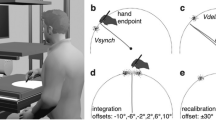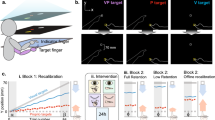Abstract
SENSORY rearrangement techniques have been used to study the way in which primates reach accurately for objects. When an object is viewed through wedge prisms, for example, reaching is disrupted but rapidly corrected when the subject is given immediate feedback concerning the position of his pointing limb relative to the target1. Such adaptation to distorted input is conventionally regarded as a process of minimising the discrepancy between two or more sensory channels (for example, vision and proprioception), with the neglected or non-dominant channel conforming to the position information provided by the other. The role of learning in this process is unclear. When the prisms are removed, the effects of such adaptation disappear rapidly (unlike most learning phenomena), and after an interval of 24 h during which the subject reaches ‘normally’, most investigators assume2 that all traces of adaptation have been eliminated from the nervous system. This view has been challenged recently by results we obtained with squirrel monkeys3, which retained their adaptation over periods often considerably longer than the 48 h spent in their home cages. We also found that they could adapt to two prisms displacing in equal and opposite directions, and eventually conserve both adaptations together with their normal reaching behaviour. Their progressive elimination of error (due to prismatic distortion) as a function of the number of occasions on which they were exposed to prism conditions suggests, furthermore, powerful motor learning mechanisms at work in the adaptation process. We now report similar findings with human subjects.
This is a preview of subscription content, access via your institution
Access options
Subscribe to this journal
Receive 51 print issues and online access
$199.00 per year
only $3.90 per issue
Buy this article
- Purchase on Springer Link
- Instant access to full article PDF
Prices may be subject to local taxes which are calculated during checkout
Similar content being viewed by others
References
Kornheiser, A. S. Psychol. Bull. 83, 783–816 (1976).
Klapp, S. T., Nordell, S. A., Hoekenga, K. C. & Patton, C. B. Percept. Psychophys. 15, 399–400 (1974).
Flook, J. P. & McGonigle, B. O. Perception 6, 15–29 (1977).
Harlow, H. F. Psychol. Rev. 56, 51–65 (1949).
McGonigle, B. O. & Flook, J. P. Psychol. Res. (in the press).
Author information
Authors and Affiliations
Rights and permissions
About this article
Cite this article
MCGONIGLE, B., FLOOK, J. Long-term retention of single and multistate prismatic adaptation by humans. Nature 272, 364–366 (1978). https://doi.org/10.1038/272364a0
Received:
Accepted:
Published:
Issue Date:
DOI: https://doi.org/10.1038/272364a0
This article is cited by
-
Visuomotor adaptation to excessive visual displacement in video see-through HMDs
Virtual Reality (2020)
-
Optimal visual–haptic integration with articulated tools
Experimental Brain Research (2017)
-
Relative errors can cue absolute visuomotor mappings
Experimental Brain Research (2015)
-
Tailoring reach-to-grasp to intended action: the role of motor practice
Experimental Brain Research (2014)
-
Sensorimotor coordination aftereffects of exposure to a virtual environment
The Visual Computer (2008)
Comments
By submitting a comment you agree to abide by our Terms and Community Guidelines. If you find something abusive or that does not comply with our terms or guidelines please flag it as inappropriate.



